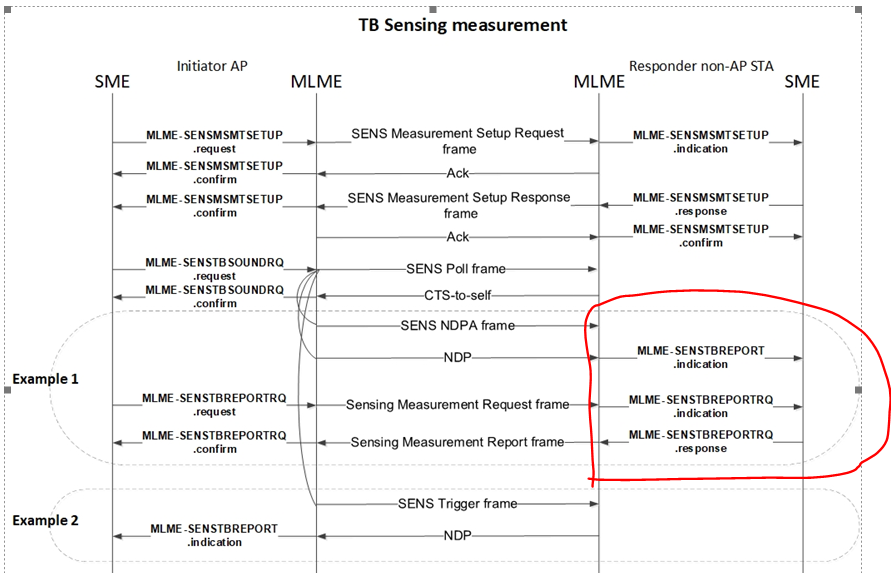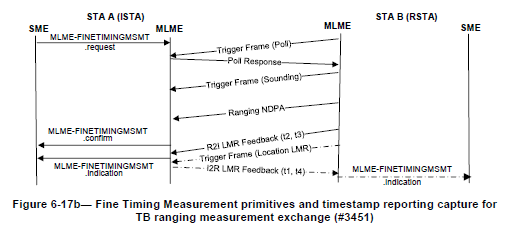Hi Rojan,
Thank you for raising the question.
I believe that the discussion allows a better understanding of the sensing basics.
Please see below my interpretation of the issue.
I see a few differences between ranging and sensing:
In the ranging
1. the report is of a single type
2. the report belongs to the last measurement and is reported in the same "SIFS" instance
3. it is the result of the single measurement
4. there is no identification of the report, like setup ID and instance ID to distinguish the report among several saved reports
In the sensing:
1. more than one type of report exists
2. the report may be delayed and reported later in another instance
3. more than one result may be delivered in one report
4. the result is identified per the setup ID/report type, and the instance ID
5. The measurement result may be consumed by the responder
"For the case when the sensing initiator is the sensing transmitter, the reporting of sensing measurement results to the sensing initiator is optional. (motion 60)"
There is the summary of my observation
Ranging: The direct MAC feedback w/o SME involvement is the best suitable presentation of the ranging interaction
Sensing:
It is more like the spectrum management and radio measurement (see 6.3.13 Protocol layer model for spectrum management and radio measurement)
The SME on the responder side is suitable to present the body responsible for the processing of the measurement results to respond with one or more report types.
It enables delivery of the results to the application for further utilization (p.5)
Best regards,
Solomon Trainin
+972547885738
From: Rojan Chitrakar <rojan.chitrakar@xxxxxxxxxxxxxxxx>
Sent: Monday, February 7, 2022 6:56 AM
To: STDS-802-11-TGBF@xxxxxxxxxxxxxxxxx
Subject: Re: [STDS-802-11-TGBF] Baseline document for the MLME TTT
WARNING:
This email originated from outside of Qualcomm. Please be wary of any links or attachments, and do not enable macros.
Hi Claudio,
Thanks for the hard work on this. I have a question for the circled portion below (MLME-SENSTBREPOTRQ):
While I agree that setup and termination should go up to the SME, I do not understand why the SME needs to be involved in the reporting phase. Shouldn’t this be handled within the MAC? Even for delayed reporting case, I struggle to think
of a reason why the SME needs to be involved. If the SME is involved, does it mean the measurement report is prepared by the SME (and not by the MAC)?

There are no such MLMEs for BF reports, and even in 11az, the feedback for FTM is handled within the MAC:

Regards,
Rojan
From: Claudio Da Silva <000015f3cbee3aeb-dmarc-request@xxxxxxxxxxxxxxxxx>
Sent: Saturday, January 29, 2022 2:24 AM
To: STDS-802-11-TGBF@xxxxxxxxxxxxxxxxx
Subject: [STDS-802-11-TGBF] Baseline document for the MLME TTT
All,
I have just uploaded the baseline document for the MLME TTT, which can be found here:
https://mentor.ieee.org/802.11/dcn/22/11-22-0233-00-00bf-proposed-draft-text-for-mlme.docx
It should be noted that the contents of this document are still being discussed by TTT. If you have any comments, send me/us a note. We will bring the document to TGbf when appropriate.
Thanks,
Claudio
To unsubscribe from the STDS-802-11-TGBF list, click the following link:
https://listserv.ieee.org/cgi-bin/wa?SUBED1=STDS-802-11-TGBF&A=1
To unsubscribe from the STDS-802-11-TGBF list, click the following link:
https://listserv.ieee.org/cgi-bin/wa?SUBED1=STDS-802-11-TGBF&A=1
To unsubscribe from the STDS-802-11-TGBF list, click the following link: https://listserv.ieee.org/cgi-bin/wa?SUBED1=STDS-802-11-TGBF&A=1